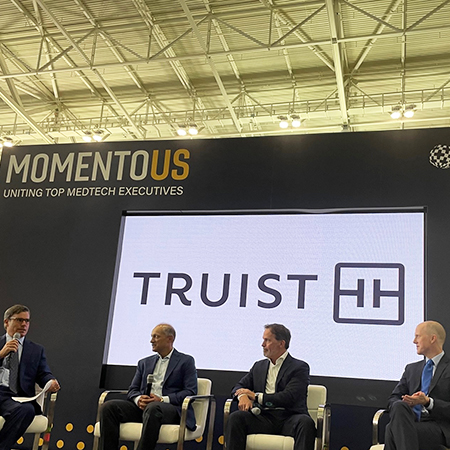Medtech Challenged To Build On 2021 Amid Threats Of Recession: Views From Industry Leaders
EY’s Pulse of the Industry report provided fodder for discussion at the AdvaMed MedTech Conference.
Executive Summary
Strong headwinds beset the medtech industry as 2022 draws to a close, including supply chain, fundraising and labor shortages. However, optimism prevailed among medtech industry leaders discussing EY’s annual Pulse of the Industry medical technology report and related topics at AdvaMed’s 2022 MedTech Conference.
The medtech sector is facing significant headwinds this year after record-breaking growth of more than 16% in 2021, driven by the resumption of deferred elective procedures and ongoing demand for diagnostics, lab equipment and other pandemic-related products, according to the 16th annual EY Pulse of the Industry medical technology report.
EY notes medtechs are adjusting to a complex environment marked by geopolitical conflict, soaring inflation, recession fears, continued supply chain issues and a tight labor market. Medtech leaders affirmed that view during panel discussions at the recent AdvaMed MedTech Conference held from 24-26 October in Boston. (Also see "AdvaMed 2022: Phiex Technologies Takes Medtech Innovator Top Honors; A Look At All Finalists" - Medtech Insight, 27 Oct, 2022.)
“As the global economy is ripe with uncertainty, medtechs are facing the new reality of new challenges in their day-to-day business,” said Jim Welch, EY global medtech leader. “While this can be a tumultuous period, the industry is healthy and continues to invest in itself. R&D spending is well above the past-decade average, new FDA approvals offer promise of more innovation, and there’s an opportunity for supply chains to be reinvented.”
He added, “If the industry can focus on making itself more resilient, there is a lot of optimism to be had.”
According to the EY report, 71% of medtechs expanded their R&D spending in 2021, and there were more than 1,800 US Food and Drug Administration clearances of medtech products in the first half of this year, putting the sector on track for the highest number of 510(k) clearances since 2012.
The surge in 510(k) clearances likely reflects a backlog of filings that accumulated in 2020 and 2021 amid large numbers of pandemic-related submissions prioritized by the agency.
Medtech revenue growth in 2021 reached its highest levels since before the 2008 financial crisis, according to EY. Companies with annual revenue over $500m experienced 16% sales growth on average last year, up from 6% in 2020. Abbott had the biggest overall top-line increase, up $7.4bn, driven primarily by its Rapid Diagnostics business. Thermo Fisher Scientific ranked second, adding $7bn to its revenues. In all, 14 companies increased their top line by over $1bn. EY noted, however, that the top-line growth did not translate to profit growth for all companies, as only 50% increased their bottom line.
Further, “It is not clear whether the industry’s outstanding performance in 2021 is a one-off impact of the pandemic or a secure basis for ongoing growth,” according to the EY report.
Investment Cools
Wary of rising uncertainties, investors have pulled back markedly, with total medtech financing down 30% for the year ended 30 June 2022. Smaller, innovative companies have been impacted in particular. Firms with less than $500m in revenues saw a drop of 35%, or nearly $10bn, according to EY.
Around 36% of the $8.5bn in venture capital raised during 2021 and 2022 came from early-stage funding rounds, with the largest venture rounds of the 12-month period going predominantly to later-stage companies, EY says.
John Babitt, EY medtech transactions leader, told reporters during an 18 October media roundtable that segments such as diagnostics, structural heart – he pointed to Edwards Lifesciences’ work in that area – and diabetes, which has seen a lot of innovation, continue to pique investors’ interest.
Medtech initial public offerings raised $4.4bn in the 12-month period, almost all of that capital raised in 2021. The first half of this year saw a “rapid decline” in medtech IPOs, with special-purpose acquisition company (SPAC) deals slowing significantly, EY notes.
EY expects medtechs’ access to public markets to be “far more constrained” in 2022, which may make acquisition a more attractive exit strategy for smaller companies.
M&A Slowing
Dealmaking has been somewhat muted in the 2022 first half. For the 12-month period ended 30 June 2022, medtechs closed M&A transactions worth $77bn in total, most occurring in the final two quarters of 2021. Total M&A spending was up 24% for the period despite a 13% drop in number of deals inked.
Babitt anticipates that reduced appetite for dealmaking will continue into the new year. (Also see "Deals Shaping The Medtech And Diagnostics Industry, August 2022" - Medtech Insight, 19 Sep, 2022.)
“Continued uncertainty in the overall financial markets continues to weigh on the M&A appetite; the overall medtech M&A and innovation ecosystem continues to remain intact, but near-term storm clouds are likely to pause transactions volumes into 2023,” he says in the report.
“This slowdown, coupled with a tighter financing environment, represents a challenging operating environment for smaller medtechs,” Babitt adds.
“Continued uncertainty in the overall financial markets continues to weigh on the M&A appetite; the overall medtech M&A and innovation ecosystem continues to remain intact, but near-term storm clouds are likely to pause transactions volumes into 2023.” – John Babitt
While medtech companies have expressed interest in acquisitions, it appears that many are taking a wait-and-see approach, with some notable exceptions.
In a recent Johnson & Johnson (Pty) Ltd call with analysts, Wells Fargo’s Larry Biegelsen asked the company’s leadership why, despite talk of “bolder steps,” we “haven’t seen more M&A from J&J so far in 2022.” The firm is sitting on $34bn in cash, but appears to be more focused on splitting off its consumer division, a move announced in 2021 and expected to be completed in 2023.
J&J’s chief financial officer Joseph Wolk said the company’s priorities haven’t changed and that “we’re even a little more bullish and eager to do something.” At the same time, the company “[doesn’t] have to do something out of desperation,” he said.
J&J announced on 1 November that it would buy heart-device maker Abiomed, Inc. for $16.6bn, the firm’s largest deal since its $30bn purchase of drugmaker Actelion in 2017 and its biggest device deal since it bought Synthes Inc. in 2012. (Also see "J&J Pumps MedTech Growth; Offers $16.6BN+ For Abiomed" - Medtech Insight, 2 Nov, 2022.)
Two other notable medtech deals this year involved software companies – Stryker Corporation's acquisition of health software company Vocera Communications for $3bn and Becton Dickinson AB’s buyout of pharmacy automation company Parata Systems for $1.5bn. (Also see "Stryker Invests Big In Connected Health Care With $3.09Bn Acquisition Of Vocera" - Medtech Insight, 6 Jan, 2022.)
During an AdvaMed panel discussion focusing on M&A in medtech and market outlook, Kevin Lobo and Tom Polen, the leaders of Stryker and Becton Dickinson, respectively, pointed to medtechs’ sharpening focus on digital technologies to make devices smarter and connect with health care systems to create efficiencies. That could be important in the context of health care labor shortages, Lobo said, pointing to a McKinsey report projecting a nationwide nursing shortage of 450,000 as early as 2025.
Polen noted, “We’re seeing more focus than ever [among hospital CEOs] and more willingness to pay for software because of that exact topic that Kevin mentioned. Whether it’s nursing shortages, pharmacist shortages … we’re seeing just labor shortages across the board … and automation, robotics and software are [among] the biggest solutions,” he said. (Also see "The Buck Stops Here: BD CEO Tom Polen On How To Make A Medtech Company Succeed" - In Vivo, 13 Jul, 2022.)
Babitt also foresees opportunities in the health care IT space as medtech companies look to integrate technologies such as virtual care and remote monitoring.
Divestitures All The Rage
Health divestitures have been trending in 2022 as a way for companies to narrow their focus on more lucrative activities.
Medtronic plc announced on 24 October it will separate its patient-monitoring and respiratory intervention businesses in an effort to bolster long-term prospects. (Also see "Medtronic Cuts Away More: Spins Off Patient Monitoring And Respiratory Business" - Medtech Insight, 25 Oct, 2022.)
BD announced in April that it had completed the planned spin-off of its diabetes business, now called embecta, and Zimmer Biomet Holdings, Inc. wrapped the spinoff of ZimVie, its former dental and spine businesses, in May. (Also see "Meet Embecta! Becton Dickinson Completes Diabetes Spin-Off" - Medtech Insight, 4 Apr, 2022.)
General Electric announced plans in November 2021 to split into three publicly traded companies focusing on energy, health care and aviation. Targeted for completion in 2023, GE HealthCare will comprise four business segments – imaging, ultrasound, patient care solutions and pharmaceutical diagnostics. GE’s strategy compares to that of rival Siemens AG, which spun off its health care business in 2018.
Asked whether spin-offs are “preferable versus acquisitions” in the industry, Welch responded, “It’s activity in both directions in order to find growth.”
In a separate, M&A-focused discussion, panelists were asked if more divestitures should be expected over the next 12 to 24 months. Zimmer Biomet CEO Bryan Hanson noted that anyone in active portfolio management needs to consider a mixture of buying and selling.
“You’ve got to move things out when they don’t make sense to your business, your strategy … you’ve got to buy in the areas where you want to drive growth and scale.” He added, “I would expect it to continue for sure [though] not so much for us, because I think we’ve done what we needed to do from an exiting standpoint.”
BD’s CEO said when he asks his investment bankers to rate the intensity of M&A activity versus spin-offs, it’s been “pretty quiet” on the M&A front, a 2 on a scale of 1-10, and much more active, 6 or 7, on the spin-out side.
“I think just in the phase that the economy is in, and the reset of valuations that are happening, we are going to see more of a portfolio pruning,” Polen said. But he wanted to go on the record that BD has no immediate plans on that.
Babitt expressed confidence in medtech’s prospects despite economic challenges, noting, “There’s a general appetite to fund medtech, even in time of a recession.” The EY leader expects M&A activity to pick up in the latter part of 2023.
New Care Models Among Opportunities
Despite challenges ahead, EY believes the medtech industry will “undoubtedly navigate upcoming challenges with agility.”
The Pulse of the Industry authors outlined four key areas of focus for companies in today’s environment: innovating and identifying new opportunities such as delivering personalized care in the home and into other non-traditional settings; exploring new commercial models; increasing supply chain resilience; and taking a new approach to recruiting talent to support new types of innovation across data, AI and connected devices.
Questions remain about whether accelerated adoption of virtual care models in response to the pandemic will continue in its aftermath. In August, the Centers for Medicare and Medicaid Services released a roadmap to end the public health emergency, but EY says it’s uncertain whether flexibilities and waivers permitted on an emergency basis will continue into 2023.
Babitt said the future of medtech, which lacks the infrastructure to go directly to consumers yet, lies in providing care outside hospitals such as in ambulatory care centers and patients’ homes. Several medtechs have struck partnerships and joint ventures with health care companies to bring technologies into these new care models.
Medtronic’s CEO Geoff Martha expressed his excitement about the future of technology during an AdvaMed panel discussing the EY report.
“There just aren’t enough people in the world, frontline health care workers, trained surgeons, to serve even this country, let alone the emerging markets around the world,” Martha said. “Technology is the path forward; technology has to take the place where there are big gaps.”
Intuitive Surgical, Inc.’s CEO Gary Guthart, who also participated in the panel discussion, similarly expressed his enthusiasm for emerging technologies – not just AI and machine learning and physical products like robotic-assisted devices – but things that are “happening on the backend.”
“I really get excited about some of the things that are at the edge of scientific discovery – the combination of molecular agents that allow for interventionalists to see things they couldn’t otherwise see and treatments they couldn’t otherwise treat,” Guthart said. He also pointed to interesting developments in the diagnostics space, such as Intuitive’s Ion endoluminal system, a robotic-assisted platform for minimally invasive biopsy of the lung, which uses a flexible catheter design.
Supply Chain Evolution
Welch said supply chain continues to be a big challenge for medtechs, especially the global semiconductor chip shortage, but applauded AdvaMed’s work with industry members to drive solutions.
“The industry working together has been one creative and important aspect of it,” Welch said during the roundtable discussion.
Babitt added that in medtech there hasn’t been investment to modernize supply chains as seen in other industries, but that’s changing.
“Our large medtech clients are upgrading technology, they’re upgrading processes, they’re upgrading sourcing,” and they’re getting creative, Babitt said. He pointed to GE Health Care’s recently announced agreement with Sociedad Quimica y Minera de Chile SA, a mining company in Chile, to secure iodinated contrast media, a substance used in X-rays and CT scans that has been in short supply.
Guthart said Intuitive, which pioneered surgical robots, has seen the “breadth of issues starting to narrow” when it comes to supply chain, but the problem is not solved. “In the near-term I don’t think there are a huge number of choices – you look for parts [where you can get them].”
Martha said a longer-term solution will require re-designing technologies.
Ashley McEvoy, J&J’s executive vice president and worldwide chairman of Medtech, affirmed that the industry is going through a “major modernization” in supply chain. (Also see "‘The Story That No One Likes To Hear’: Investors Looking For Surer Bets In Health Tech After Record 2021" - Medtech Insight, 18 Aug, 2022.)
The industry leaders also discussed talent recruitment, with Martha suggesting a need to cast a wider net in order to reach “people from industries that are best-in-class.” He said Medtronic “tends to be a little homegrown from within the company, but also from within medtech.”
A big focus at the AdvaMed MedTech Conference was the need to improve access to care for underserved populations. In June, AdvaMed released a report titled “Approaches to Increasing Diversity in Clinical Research and Addressing Health Inequities” after developing in 2020 a set of principles to promote inclusion and equity in health care and medtech research.
Edwards Lifesciences CEO Mike Mussallem told Medtech Insight just prior to the start of the conference that “we probably need to improve the terms of the way that we operate [as an industry], and “we’ll talk about that [at AdvaMed].” (Also see "Getting Personal With Edwards’ Mike Mussallem: Hard Work, Giving Back And Changing The Practice Of Medicine" - Medtech Insight, 17 Oct, 2022.)


